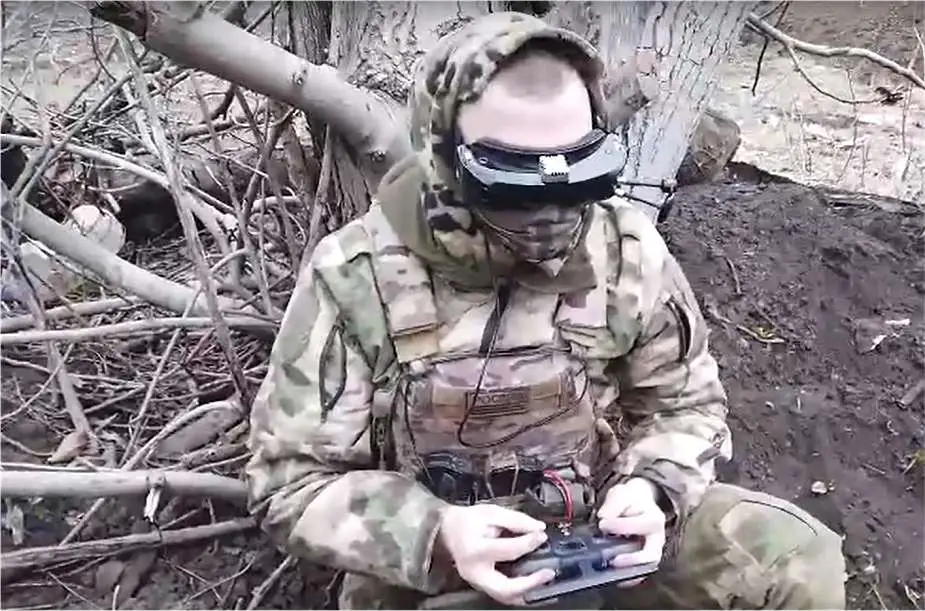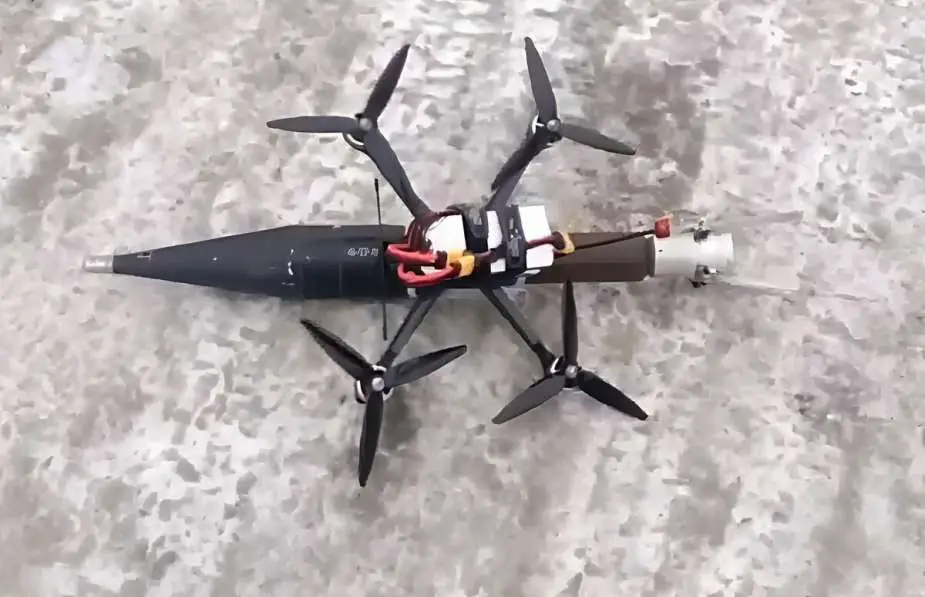- Army
- Conflicts in the world
- Israel - Iran conflict 2025
- Pakistan - India Conflict 2025
- Russia Ukraine War 2022
- Libya conflict day by day
- HAMAS - Israel War 2023
- Operation Serval in Mali French Army
- Sangaris operation Central African Republic
- Sangaris opération militaire République Centreafrique
- Ukraine - Russia conflict
- Syria conflict news
- Defence & Security Industry Technology
- Armies in the world
- Analysis Defense and Security Industry
- Conflicts in the world
- Navy
- Air
Russia intensifies use of armed FPV First Person View drones to strike Ukrainian positions
The use of First Person View (FPV) drones in the ongoing conflict between Russian and Ukrainian forces has evolved into a significant aspect of modern warfare tactics. On the Russian side, these drones are not only being used for surveillance but have been adapted for direct strikes against Ukrainian positions, creating a formidable challenge for the Ukrainian Armed Forces.
Follow Army Recognition on Google News at this link

A Russian soldier operates an FPV armed drone with a 3D goggle. (Picture source Russian MoD)
Russian forces have innovated in their use of FPV drones by equipping them with night-vision capabilities, allowing for strikes under the cover of darkness. This has marked a tactical shift, as such operations undermine the previously held technological advantages of the Ukrainian forces during nighttime. Ukrainian military personnel have reported the use of FPV drones equipped with heat-detecting cameras, which are capable of identifying targets with minimal lighting or even through thermal signatures. This development poses a serious problem for Ukrainian logistics and operations, which traditionally took advantage of the night for movements and rotations.
In specific instances, the Russian military has used FPV drones to target Ukrainian military personnel hiding in bunkers in the Zaporizhia region. Such drones, controlled by operators wearing specialized VR goggles, have been successful in eliminating targets by deploying kamikaze tactics. This method involves tracking down Ukrainian fighters concealed in forested areas or bunkers and then using drones to execute precision strikes.
Russian military personnel, specifically from the special mining battalion of the “Southern” group of forces, have been actively deploying FPV drones to strike enemy targets in the Seversky direction. A notable advancement in their operational capabilities is the use of 3D printing technology to create special mounts for these drones. These mounts are designed to equip the drones with standard engineered ammunition, effectively transforming them into unmanned, flying munitions platforms. The operators can mount various explosive charges on these drones, including KZ-6 shaped charges and rockets from the RPG-7 anti-tank grenade launcher, depending on the tactical requirements of their missions.
The KZ-6 shaped charges, part of a wider range of demolition charges developed in Russia, are designed for a variety of applications including breaching armor and fortified structures. The KZ-6, with its conical liner and sealed forward chamber, is capable of forming a jet underwater, showcasing its versatility in different operational contexts. It can create a hole of 215 mm depth and 20 mm diameter in steel, or 800 mm depth and 50 mm diameter in frozen ground, indicating its substantial destructive capability.
The adaptation of these charges for use in FPV (First Person View) drones marks a significant evolution in their application, particularly highlighted in the context of the ongoing conflict between Russian and Ukrainian forces. These drones, equipped with KZ-6 charges, can deliver precise strikes against enemy armor, personnel, and fortifications, leveraging the element of surprise and the capability to hit from angles that are challenging for traditional ground attacks.
Specifically, the Lancet kamikaze drone, a notable platform for the KZ-6 charge, has been used extensively by Russian forces. This drone, which can be equipped with up to 1.5 kg of TG-40 explosive contained within the KZ-6, is designed to penetrate up to 215 mm of armor or 550 mm of concrete, illustrating the high degree of lethality it can deliver against fortified positions or armored vehicles. The KZ-6's effectiveness is further enhanced when used in drones, as it allows for targeted strikes against critical assets with reduced risk to the operating forces.

Russian Astron Design Bureau has developed new attack drones using shells from an RPG-7 grenade launcher. (Picture source Russia n Social Network)
Mounting RPG-7 rockets on FPV drones offers significant destructive capabilities, leveraging the RPG-7's versatility and effectiveness. The RPG-7 is a portable, reusable, unguided, shoulder-launched, anti-tank rocket launcher, renowned for its ruggedness, simplicity, low cost, and effectiveness, making it the most widely used anti-armor weapon globally. It can fire various warhead types, including high-explosive anti-tank (HEAT) rounds, high explosive/fragmentation, and thermobaric warheads, allowing it to tackle a range of targets from armored vehicles to fortified positions and personnel.
The RPG-7's ammunition types cater to different targets, enhancing the FPV drone's operational flexibility. For instance, its single-stage HEAT projectile (RPG-7VL) can penetrate up to 500mm of armor, suitable for anti-vehicle and anti-fortification roles. The tandem HEAT projectile (RPG-VR) can penetrate 600-700mm of armor, effective against heavily armored targets, including those equipped with reactive armor. The fragmentation projectile (OG-7V) has an effective range of approximately 7.01 meters (23 feet), primarily used for anti-personnel purposes. Lastly, the thermobaric projectile (TBG-7V) offers an effective range of approximately 10.06 meters (33 feet), ideal for anti-personnel use and urban warfare scenarios.
Further emphasizing its versatility, the RPG-7's warheads have evolved significantly, with innovations such as the PG-7VL and PG-7VR HEAT rounds that can penetrate substantial armor thicknesses, and the TBG-7V thermobaric round designed for urban combat. These developments underscore the weapon's adaptability to modern combat challenges.
By integrating RPG-7 rockets into FPV drone operations, forces can extend the reach of this time-tested weapon, allowing for precise strikes against diverse targets from a distance, thus combining the advantages of aerial surveillance and direct fire support in a novel and potent manner.
Moreover, the deployment of FPV drones has extended to direct combat engagements, where Russian paratroopers have utilized these drones in conjunction with traditional ground operations. The effectiveness of FPV drones in deterring Ukrainian tanks and eliminating personnel has been highlighted, showcasing the integration of unmanned aerial technology into conventional warfare tactics.
The adaptation and use of FPV drones by Russian forces represent a significant shift in modern warfare, emphasizing the increasing role of unmanned systems and night-vision technology. The Ukrainian military's response to these challenges includes adapting their own drone technology and tactics, indicating an ongoing evolution in the technological arms race on the battlefield.
News Russia Ukraine War


























